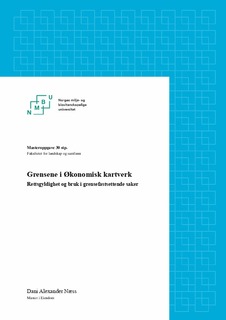| dc.contributor.advisor | Tenge, Gunnar | |
| dc.contributor.author | Næss, Dani Alexander | |
| dc.coverage.spatial | Norway | nb_NO |
| dc.date.accessioned | 2019-07-16T12:17:56Z | |
| dc.date.available | 2019-07-16T12:17:56Z | |
| dc.date.issued | 2019 | |
| dc.identifier.uri | http://hdl.handle.net/11250/2605526 | |
| dc.description.abstract | MÅL: Målet med masteroppgaven er å studere faktisk bruk av eiendomsgrenser i Økonomiske Kartverk (ØK) til å fastsette eiendomsgrenser i grensefastsettende saker, om det har vært en økende bruk over tid og om de ulike rettsinstansene benytter eiendomsgrensene i ØK likt. I tillegg vil studien belyse vurderinger retten tar ved bruk av grensene i ØK - altså hva retten vurderer rundt eiendomsgrensene i ØK sin rettsgyldighet.
BAKGRUNN: Grensene i ØK er stadfestet som ikke rettsgyldige samtidig som det er mye litteratur som sier at kartverkets grenser har økt bevisverdi. ØK er også veldig tilgjengelig, og bringes derfor ofte frem for retten som et bevis som retten må ta stilling til i rettsavgjørelser. Litteraturen viser at det eksisterer uenigheter rundt vurderingen av grensene i ØK og lite litteratur eksisterer rundt hva det vil si at grensene i ØK har økt bevisverdi, men mangler rettsgyldighet.
METODE: Det ble utviklet en hovedproblemstilling og 4 delproblemstillinger og det ble benyttet et systematisk søk i lovdata Pro for å finne aktuelle rettsavgjørelser. Delproblemstilling 1-3 omhandler en opptelling av hvor mange saker som benytter grensene i ØK til å stadfeste grenser. For å besvare dette er det benyttet et deduktivt studium med hypoteser og et kvantitativt dokumentstudium med en univariat analyse. Delproblemstilling 4 benytter juridisk metode og undersøker hva faktisk retten benytter som argumentasjon ved deres vurdering av bruk av grensene i ØK.
RESULTATER OG DISKUSJON: Masteroppgaven konkluderer med at de fleste grensefastsettende sakene ikke benytter grensene i ØK til å stadfeste eiendomsgrenser (63%), men det er likevel en betydelig andel som enten benytter grensene i ØK som hovedargument til å fastsette eiendomsgrenser (16%) eller til å bygge opp argumentasjonen til å fastsette eiendomsgrenser (21%). Lagmannsretten (19%) benytter grensene i ØK til å stadfeste grenser i noe større grad enn jordskifteretten (12%). Det har ikke vært økende bruk av grensene i ØK til å fastsette grenser de siste 10 årene. Studien avdekker at det er mye uenigheter rundt temaet og at de samme argumentene benyttes både for og mot bruk av grensene i ØK til å fastsette grenser. Det er tydelig at bruk av grensene i ØK til å fastsette grenser er et omdiskutert moment under rettsavgjørelsene i studien, og der rettsavgjørelsene ikke er enstemmig. | nb_NO |
| dc.description.abstract | OBJECTIVE: The aim of this master thesis is to study the use of property borders in economic maps to decide borders in boundary determination cases, if there has been an increased use over time and if the different civil courts have similar use of the property borders in economic maps. Additionally, the thesis will investigate the evaluations and verdicts the courts conclude – what the courts think about the property borders in economic maps and their legal validity.
BACKGROUND: The borders in economic maps are not defined as legally valid, but there is literature saying that economic maps has increased in evidentiary value. Economic maps are easily available and is therefore often brought to court as evidence that the judges must take in to consideration when passing their verdicts. The literature shows that there have been disagreements surrounding the evaluation of the borders in economic maps, and little literature exist explaining what it means that the boundaries in economic maps have increased evidentiary value, yet lacks legal validity.
METHOD: To answer the main research question in the thesis there was developed four smaller research questions; which were answered with the use of a systematic search in “lovdata Pro” to find court decisions discussing or using the borders in economic maps.
Research question 1-3 uses a deductive approach with hypotheses and a quantitative document study with a univariate analysis counting how many of the cases that uses the borders in economic maps to decide the borders. Research question 4 uses a legal methodology to look at what the court uses as argumentation in their assessment of use of the borders in economic maps.
RESULTS AND DISCUSSION: The master thesis concluded that amongst the boundary determination cases, the majority (63%) did not use the borders in economic maps to decide where the property borders are. Nevertheless, a considerable part of the court verdicts used the borders in economic maps as a main argument (16%) to decide where the property borders are or as an argumentation to support other evidence (21%). The court of appeal (19%) uses the borders in economic maps more than the land consolidation court (12%) to decide where the property borders are. There has not been an increased amount of use of the borders in economic map to decide where the property borders are in boundary determination cases the last 10 years. The study reveals that there is a lot of disagreement surrounding the topic and that the same argumentation is used both for and against the use of the borders in economic maps to decide where the property borders are. The use of the borders in economic maps is a disputed topic in the court verdicts in the study and where the court rooms are not unanimous. | nb_NO |
| dc.language.iso | nob | nb_NO |
| dc.publisher | Norwegian University of Life Sciences, Ås | nb_NO |
| dc.rights | Attribution-NonCommercial-NoDerivatives 4.0 Internasjonal | * |
| dc.rights.uri | http://creativecommons.org/licenses/by-nc-nd/4.0/deed.no | * |
| dc.subject | Bevisverdi | nb_NO |
| dc.subject | Rettsgyldighet | nb_NO |
| dc.subject | Eiendomsgrenser | nb_NO |
| dc.title | Grensene i Økonomisk kartverk : rettsgyldighet og bruk i grensefastsettende saker | nb_NO |
| dc.type | Master thesis | nb_NO |
| dc.source.pagenumber | 52 | nb_NO |
| dc.description.localcode | M-EIE | nb_NO |

